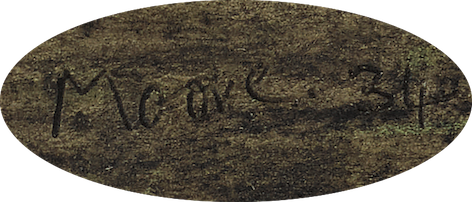

(Castelford, Royaume-Uni 1898 - Much Hadham, Royaume-Uni, 1986)

Born in England in a family of miners, Henry Moore was a soldier in the north of France during the First World War.
Having a real gift for sculpture, he studied at the Leeds School of Art and then at the Royal College of Art in London from 1920 to 1924. His first exhibition, organized in 1928, blended art first and primitive art. His approach was to bring out 'the truth of the material' by sculpting directly in wood or stone.
In 1933, he co-founded Unit One, which brought together artists and architects interested in either constructivism or surrealism. He then participated in the international exhibition of surrealism in London.
During the Second World War, Henry Moore made a series of drawings on refugees crammed into London subway shelters. In 1948, he received the Sculpture Grand Prix of the Venice Biennial.
The post-war period marked the beginning of teaching for Henry Moore, who trained sculptors in his studio in London. He created individual and group characters, carved wood, stone and made bronze prints.
A recognized sculptor, he carried out many public commissions. Working on the relationship between art and nature and wishing to create a privileged link between the work and its environment, he integrated his monumental sculptures in nature.
He created the Henri Moore Foundation in 1972 to promote the popularization of art and to preserve his sculptures. The foundation now operates as a gallery and museum at the Henry Moore workshops in Hoglands Park Southampton, England.
His monumental sculptures, abstract works and human silhouettes are now known all around the world.